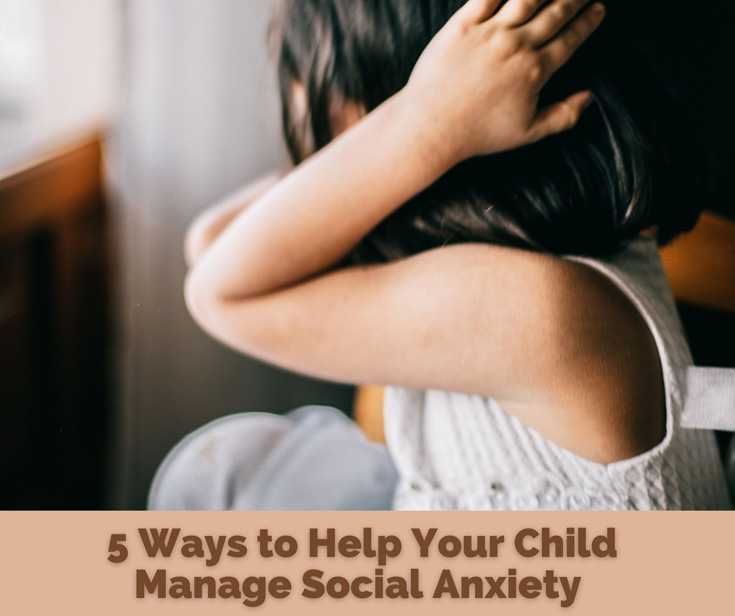If your child is afraid to fail, make mistakes, let others down or be embarrassing, they’re likely struggling with some form of social anxiety. This mental health condition can prevent them from adopting a growth mindset, trying new things, taking risks and connecting with others. Luckily, there are ways to help your child manage social anxiety so they can take life by the reins and embrace their full potential.

1. Use the PACE Model
Engage with your child and help them feel safe by using the PACE model. This method stands for Playfulness, Acceptance, Curiosity and Empathy, all of which you should rely upon when interacting with your child. For instance, if your child is nervous about meeting new people, you can use playfulness to lighten the mood and help them feel open and relaxed. Meanwhile, you can practice unconditional acceptance in regard to your little one’s wishes, feelings, thoughts and perceptions to make them feel safe.
Use the third element, curiosity, to explore feelings and urges and help your child communicate the reason behind their anxious behaviors. Once they open up and share their thoughts, it’s important to show them empathy. Let your child know that you feel their sadness and distress to provide emotional comfort and support. By using this four-step approach, you can often reduce conflict, defensiveness and withdrawal and coax your child into managing their social anxiety in healthy ways.
2. Normalize About Social Anxiety
Over the past few years, there’s been less of a stigma surrounding mental health issues. However, it’s still important to talk to your kids about social anxiety and have open discussions about why anxiety exists.
As humans, anxiety is a normal and natural response to danger, something that kept us alive during our primal evolution. Now, however, we don’t have to worry about lions or enemy tribes attacking us, so our brains look for other stressors, which can often lead to social anxiety. The good news is you can reprogram your brain to respond calmly to external stimuli. Understanding why anxiety exists will simply help you and your child identify triggers and overcome this automatic response.
3. Prepare for Interaction
You can also ease your child’s anxiety by preparing them for social interactions. Before your little one meets up with a friend or interacts with a new group of people, prepare them as much as possible by giving them a detailed play-by-play of what will happen. Giving them this information will help the situation feel more familiar when it finally plays out and give your little one a sense of control.
Many kids will consider joining team sports around age four, at which point they might express some anxiety about playing with other children. Instead of simply talking about possible situations, show them photos and videos of other kids playing sports and having fun together. Read books about overcoming nervousness and being a team player and visit the school soccer field or baseball diamond so the environment feels familiar when they finally do join the team.
4. Have Worry Time
Sometimes, the best thing you can do for your child is let them worry. Instead of being optimistic, set a timer and allow your little one to explore every possible negative outcome for a few minutes. Stay with them as they catastrophize to reinforce feelings of safety. Then, when worry time is over, talk about the ideas and feelings that came up. Remember to accept their worries as real empathize with their fear of the unknown.
Finally, find a solution to help your kid through the scary experience they’re anticipating. Brainstorm ways to lessen the possibility of bad things happening and talk about what they might do if the worst possible scenario does play out. Often, preparing for the worst will help them view new experiences in a more positive light, which can minimize anxiety over time.
5. Teach Coping Techniques
Teaching your child a few healthy coping techniques can also be a great way to end worry time or prepare for a potentially stressful situation. Help your kid recognize the symptoms of social anxiety, like tummy aches, shortness of breath and sweaty palms. Then, teach them how to cope with these feelings and sensations so they can overcome their social anxiety and learn to interact calmly.
One such coping technique is cyclical breathing. Slow the sympathetic nervous system and lower blood pressure by breathing in to a count of four, and then breathing out for an equal count. Other coping strategies might include relaxing activities or and mindfulness techniques like body scans and even meditation.
Adjusting Your Expectations
As a parent, you might feel pressure to be like everyone else, which can cause you to put unrealistic expectations on your socially anxious child. In difficult social situations, it’s important to adjust your expectations and accept that anxiety is part of your kid’s personality, not a deficiency. What your child considers enjoyable might not match their peers’, and that’s ok.
Learn to rethink your perception of fun and let go of your own expectations. If you’re doing everything you can to help your child manage their social anxiety, then the rest is up to them.






Speak Your Mind